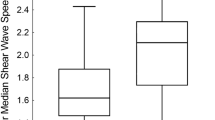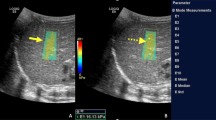Abstract
Background
While liver biopsy remains the gold standard, given the procedure risks and sampling errors, there is a need for reliable noninvasive biomarkers of hepatic fibrosis.
Objective
Determine the accuracy of two-dimensional shear wave elastography (2-D SWE) in predicting the histological severity of liver fibrosis in pediatric patients with known or suspected liver disease.
Materials and methods
Subjects 0–18 years old with known or suspected liver disease and liver biopsy within 30 days (n=70) were included. Comparisons by 2-D SWE were made to a control group (n=79). Two-dimensional SWE was performed using the GE LOGIQ E9 system. Liver biopsy specimens were scored according to METAVIR and Ishak scoring systems using Spearman’s Rho correlation. Receiver operator characteristic (ROC) analysis, Kruskal-Wallis and Mann-Whitney U tests were conducted.
Results
Control group median 2-D SWE measurements were lower than in subjects with any degree of liver fibrosis (P<0.001). Those with METAVIR F0 and Ishak 0 scores had significantly lower median 2-D SWE measurements (1.35 m/s; 1.36 m/s) than those with more advanced liver disease (F1-F3: 1.49–1.62 m/s; 1–4: 1.45–1.63 m/s) (P<0.05 for all), whereas the 2-D SWE in the higher scores were similar. Results did not differ between METAVIR and Ishak scores for any degree of fibrosis. Fibrosis scores moderately correlated with median 2-D SWE measurements (rs=0.43). The area under the curve for F1 compared to combined control/F0 was 0.89 (95% confidence interval [CI] 0.83–0.95; P<0.001) with sensitivity of 94.6% and specificity of 78.6%. Results for Ishak score 1 were similar. The ideal cutoff value for identifying fibrosis was determined to be 1.29 m/s.
Conclusion
The liver 2-D SWE measurements correlated with the histological liver fibrosis scores, regardless of the histopathological scoring system, although 2-D SWE was better at identifying patients with early fibrosis, not at distinguishing among the individual fibrosis levels. Two-dimensional SWE using the GE LOGIQ US system is useful for identifying pediatric patients at risk for liver fibrosis.



Similar content being viewed by others
References
Barr RG, Ferraioli G, Palmeri ML et al (2015) Elastography assessment of liver fibrosis: Society of Radiologists in ultrasound consensus conference statement. Radiology 276:845–861
Shan QY, Liu BX, Tian WS et al (2016) Elastography of shear wave speed imaging for the evaluation of liver fibrosis: a meta-analysis. Hepatol Res 46:1203–1213
Jiang T, Tian G, Zhao Q et al (2016) Diagnostic accuracy of 2D-shear wave elastography for liver fibrosis severity: a meta-analysis. PLoS One 11:e0157219
Li C, Zhang C, Li J et al (2016) Diagnostic accuracy of real-time shear wave elastography for staging of liver fibrosis: a meta-analysis. Med Sci Monit 22:1349–1359
Samir AE, Dhyani M, Vij A et al (2015) Shear-wave elastography for the estimation of liver fibrosis in chronic liver disease: determining accuracy and ideal site for measurement. Radiology 274:888–896
Bert F, Stahmeyer JT, Rossol S (2016) Ultrasound elastography used for preventive non-invasive screening in early detection of liver fibrosis. J Clin Med Res 8:650–655
Varbobitis IC, Siakavellas SI, Koutsounas IS et al (2016) Reliability and applicability of two-dimensional shear-wave elastography for the evaluation of liver stiffness. Eur J Gastroenterol Hepatol 28:1204–1209
Jain V, Dixit R, Chowdhury V et al (2016) Can acoustic radiation force impulse elastography be a substitute for liver biopsy in predicting liver fibrosis? Clin Radiol 71:869–875
Zeng J, Liu GJ, Huang ZP et al (2014) Diagnostic accuracy of two-dimensional shear wave elastography for the non-invasive staging of hepatic fibrosis in chronic hepatitis B: a cohort study with internal validation. Eur Radiol 24:2572–2581
Huang ZP, Zhang XL, Zeng J et al (2014) Study of detection times for liver stiffness evaluation by shear wave elastography. World J Gastroenterol 20:9578–9584
Jeong JY, Kim TY, Sohn JH et al (2014) Real time shear wave elastography in chronic liver diseases: accuracy for predicting liver fibrosis, in comparison with serum markers. World J Gastroenterol 20:13920–13929
Yoon JH, Lee JM, Han JK, Choi BI (2014) Shear wave elastography for liver stiffness measurement in clinical sonographic examinations: evaluation of intraobserver reproducibility, technical failure, and unreliable stiffness measurements. J Ultrasound Med 33:437–447
Cassinotto C, Boursier J, de Ledinghen V et al (2016) Liver stiffness in nonalcoholic fatty liver disease: a comparison of supersonic shear imaging, Fibroscan, and ARFI with liver biopsy. Hepatology 63:1817–1827
Fraquelli M, Baccarin A, Casazza et al (2016) Liver stiffness measurement reliability and main determinants of point shear-wave elastography in patients with chronic liver disease. Aliment Pharmacol Ther 356-365(15):44
Bamber J, Cosgrove D, Dietrich CF et al (2013) EFSUMB guidelines and recommendations on the clinical use of ultrasound elastography. Part 1: basic principles and technology. Ultraschall Med 34:169–184
Cosgrove D, Piscaglia F, Bamber J et al (2013) EFSUMB guidelines and recommendations on the clinical use of ultrasound elastography. Part 2: clinical applications. Ultraschall Med 34:238–253
Paparo F, Corradi F, Cevasco L et al (2014) Real-time elastography in the assessment of liver fibrosis: a review of qualitative and semi-quantitative methods for elastogram analysis. Ultrasound Med Biol 40:1923–1933
Zaleska-Dorobisz U, Kaczorowski K, Pawlus A et al (2014) Ultrasound elastography—review of techniques and its clinical applications. Adv Clin Exp Med 23:645–655
Noruegas MJ, Matos H, Goncalves I et al (2012) Acoustic radiation force impulse-imaging in the assessment of liver fibrosis in children. Pediatr Radiol 42:201–204
Marginean CO, Marginean C (2012) Elastographic assessment of liver fibrosis in children: as prospective single center experience. Eur J Radiol 81:e87–e874
Hanquinet S, Courvoisier D, Kanavaki A et al (2013) Acoustic radiation force impulse imaging—normal values of liver stiffness in healthy children. Pediatr Radiol 43:539–544
Hanquinet S, Rougemont AL, Courvoisier D et al (2013) Acoustic radiation force impulse (ARFI) elastography for the noninvasive diagnosis of liver fibrosis in children. Pediatr Radiol 43:545–551
Tutar O, Beser OF, Adaletli I et al (2014) Shear wave elastography in the evaluation of liver fibrosis in children. J Pediatr Gastroenterol Nutr 58:750–755
Dillman JR, Heider A, Bilhartz JL et al (2015) Ultrasound shear wave speed measurements correlate with liver fibrosis in children. Pediatr Radiol 45:1480–1488
Phelps A, Ramachandran R, Courtier J et al (2016) Ultrasound elastography: is there a shear wave speed cutoff for pediatric liver fibrosis and inflammation? Clin Imaging 41:95–100
Özkan MB, Bilgici MC, Eren E et al (2017) Role of point shear wave elastography in the determination of the severity of fibrosis in pediatric liver diseases with pathologic correlations. J Ultrasound Med 36:2337–2344
Lodwick D, Dienhart M, Cooper JN et al (2017) A pilot study of ultrasound elastography as a non-invasive method to monitor liver disease in children with short bowel syndrome. J Pediatr Surg 52:962–965
Burak Özkan M, Bilgici MC, Eren E, Caltepe G (2018) Diagnostic accuracy of point shear wave elastography in the detection of portal hypertension in pediatric patients. Diagn Interv Imaging 99:151–156
Franchi-Abella S, Corno L, Gonzales E et al (2016) Feasibility and diagnostic accuracy of supersonic shear-wave elastography for the assessment of liver stiffness and liver fibrosis in children: a pilot study of 96 patients. Radiology 278:554–562
Belei O, Sporea I, Gradinaru-Tascau O et al (2016) Comparison of three ultrasound based elastographic techniques in children and adolescents with chronic diffuse liver diseases. Med Ultrason 18:145–150
Bailey SS, Youssfi M, Patel M et al (2017) Shear-wave ultrasound elastography of the liver in normal-weight and obese children. Acta Radiol 58:1511–1518
Dhyani M, Gee MS, Misdraji J et al (2015) Feasibility study for assessing liver fibrosis in paediatric and adolescent patients using real-time shear wave elastography. J Med Imaging Radiat Oncol 59:687–694
Yoon HM, Cho YA, Kim JR et al (2017) Real-time two-dimensional shear-wave elastography for liver stiffness in children: interobserver variation and effect of breathing technique. Eur J Radiol 97:53–58
Garcovich M, Veraldi S, Di Stasio E et al (2017) Liver stiffness in pediatric patients with fatty liver disease: diagnostic accuracy and reproducibility of shear-wave elastography. Radiology 283:820–827
Alison M, Biran V, Tanase A et al (2015) Quantitative shear-wave elastography of the liver in preterm neonates with intra-uterine growth restriction. PLoS One 10:e0143220
Bedossa P, Dargère D, Paradis V (2003) Sampling variability of liver fibrosis in chronic hepatitis C. Hepatology 38:1449–1457
Ishak K, Baptista A, Bianchi L et al (1995) Histological grading and staging of chronic hepatitis. J Hepatol 22:696–699
Brunt EM, Janney CG, Di Bisceglie AM et al (1999) Nonalcoholic steatohepatitis: a proposal for grading and staging the histological lesions. Am J Gastroenterol 94:2467–2474
Galina P, Alexopoulou E, Zellos A et al (2019) Performance of two-dimensional ultrasound shear wave elastography: reference values of normal liver stiffness in children. Pediatr Radiol 49:91–98
VassarStats: Website for Statistical Computation created by Richard Lowry 2001-2019. http://vassarstats.net/ Accessed 13 May 2019
Andersen SB, Ewertsen C, Carlsen JF et al (2016) Ultrasound elastography is useful for evaluation of liver fibrosis in children—a systematic review. J Pediatr Gastroenterol Nutr 63:389–399
Pellot-Barakat C, Chami L, Correas JM et al (2016) Does motion affect liver stiffness estimates in shear wave elastography? Phantom and clinical study. Eur J Radiol 85:1645–1650
Guzmán-Aroca F, Frutos-Bernal MD, Bas A et al (2012) Detection of non-alcoholic steatohepatitis in patients with morbid obesity before bariatric surgery: preliminary evaluation with acoustic radiation force impulse imaging. Eur Radiol 22:2525–2532
Dhyani M, Anvari A, Samir AE (2015) Ultrasound elastography: liver. Abdom Imaging 40:698–708
Bota S, Sporea I, Peck-Radosavljevic M et al (2013) The influence of aminotransferase levels on liver stiffness assessed by acoustic radiation force impulse elastography: a retrospective multicenter study. Dig Liver Dis 45:762–768
Fierbinteanu-Braticevici C, Sporea I, Panaitescu E, Tribus L (2013) Value of acoustic radiation force impulse imaging elastography for non-invasive evaluation of patients with nonalcoholic fatty liver disease. Ultrasound Med Biol 39:1942–1950
Yoon KT, Lim SM, Park JY et al (2012) Liver stiffness measurement using acoustic radiation force impulse (ARFI) elastography and effect of necroinflammation. Dig Dis Sci 57:1682–1691
Ferraioli G, Tinelli C, Dal Bello B et al (2012) Accuracy of real-time shear wave elastography for assessing liver fibrosis in chronic hepatitis C: a pilot study. Hepatology 56:2125–2133
Palmeri ML, Wang MH, Rouze NC et al (2011) Noninvasive evaluation of hepatic fibrosis using acoustic radiation force-based shear stiffness in patients with nonalcoholic fatty liver disease. J Hepatol 55:666–672
Motosugi U, Ichikawa T, Niitsuma Y, Araki T (2011) Acoustic radiation force impulse elastography of the liver: can fat deposition in the liver affect the measurement of liver stiffness? Jpn J Radiol 29:639–643
GE Healthcare (2014) LOGIQ E9 shear wave elastography. https://www.logiqclub.net/us/white-papers Accessed 4 May 2019
Acknowledgments
Funding support was provided by the Society for Pediatric Radiology Research and Education Foundation, the Thrasher Research Fund, GE Healthcare and the St. Louis University School of Medicine Department of Pediatrics in association with the Cardinal Glennon Foundation (Fleur de Lis and Signature Fund grants). GE Healthcare also provided a LOGIQ E9 system for use during the study period.
Author information
Authors and Affiliations
Corresponding author
Ethics declarations
Conflicts of interest
Dr. Farmakis has research grants from GE Healthcare and Guerbet, LLC, and is a consultant for GE Precision Healthcare, LLC. Dr. Jain is a consultant and speaker for Alexion Pharmaceuticals.
Additional information
Publisher’s note
Springer Nature remains neutral with regard to jurisdictional claims in published maps and institutional affiliations.
Rights and permissions
About this article
Cite this article
Farmakis, S.G., Buchanan, P.M., Guzman, M.A. et al. Shear wave elastography correlates with liver fibrosis scores in pediatric patients with liver disease. Pediatr Radiol 49, 1742–1753 (2019). https://doi.org/10.1007/s00247-019-04493-3
Received:
Revised:
Accepted:
Published:
Issue Date:
DOI: https://doi.org/10.1007/s00247-019-04493-3




